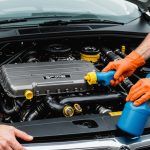Overview of Safe Cars for Teen Drivers
Choosing safe cars for UK teen drivers is crucial for their wellbeing on the road. It can significantly influence their driving experience and safety as new drivers. Teen driver car safety is not just about the vehicle’s capability to withstand collisions but encompasses a range of features and considerations.
Safety Features to Consider
When evaluating cars for teen drivers, it’s vital to focus on features designed to enhance safety. Advanced safety systems such as automatic emergency braking, lane departure warning, and stability control are key. These technologies help prevent accidents by alerting drivers or autonomously responding to potential hazards.
Also read : Ultimate Guide to Assessing and Reducing Your Vehicle”s Environmental Footprint in the UK
Additionally, selecting a vehicle with multiple airbags and a sturdy frame can provide substantial protection during an impact. Visibility, often improved by crash avoidance technology like blind-spot monitors, also plays a significant role in teen driver car safety.
UK Regulations Impacting Teen Drivers
In the UK, specific regulations target teen drivers to ensure their safety. Provisional licenses allow new drivers to practice under supervision, mandating the use of “L” plates. Furthermore, the UK law imposes restrictions on night-time driving and the number of passengers a novice can carry. These regulations aim at reducing distractions and risks. Understanding and adhering to these guidelines is vital for ensuring safety on the roads for teen drivers.
Also to read : Selecting the Best Motor Oil for High-Mileage Cars in the UK: A Comprehensive Guide
Recommended Cars for Teen Drivers
Selecting the best cars for new drivers involves considering safety, cost, and practicality. With numerous options available, it’s essential to choose wisely for your teenager’s first vehicular experience.
Compact Cars
Compact cars present an excellent choice due to their affordability, fuel efficiency, and ease of manoeuvrability. Models like the Honda Civic and Toyota Corolla are renowned for their high safety ratings. These vehicles offer superior crash protection and include features like anti-lock brakes and stability control, crucial for inexperienced drivers. Additionally, their smaller size makes them ideal for navigating in tight spaces or urban environments, aiding safety for young drivers.
Sedans
Popular sedans such as the Hyundai Elantra and Mazda3 are frequently recommended for teenagers. These vehicles provide a balanced mix of safety features and modern technology, enhancing the driving experience. Sedans generally have lower insurance costs compared to other vehicle types, making them a financially sound choice. Ensuring your young driver has a safe, cost-effective vehicle with robust safety ratings is an intelligent parental precaution.
SUVs and Crossovers
SUVs and crossovers like the Subaru Outback or Honda CR-V offer increased visibility and robust safety features, including advanced driver-assistance systems (ADAS). These attributes make them attractive vehicles for teenagers. However, new drivers should exercise caution, as larger vehicles may pose challenges in parking and handling. Balancing these considerations, SUVs remain a practical option when prioritising safety and comfort.
Safety Features Essential for Teen Drivers
Ensuring the safety of teen drivers is paramount, and essential car features play a vital role in protecting young drivers. Modern vehicles are equipped with advanced driver-assistance systems (ADAS) that provide crucial support. These systems act as a second pair of eyes, alerting drivers to potential hazards and assisting in maintaining safe driving practices.
Airbags and structural integrity are fundamental aspects of a car’s safety features. Airbags, when combined with a vehicle’s structural design, significantly reduce the risk of injury in a collision. A well-designed structure absorbs impact energy, minimizing the force experienced by passengers.
Stability control and traction control are also critical in maintaining vehicle control, especially on slippery roads or in adverse weather conditions. These systems automatically apply brakes to individual wheels, helping prevent skidding and maintaining traction.
By understanding the importance of essential car features such as ADAS, airbags, structural integrity, stability control, and traction control, parents can make informed decisions when selecting a vehicle for their teen driver. Equipping young drivers with a vehicle that includes these safety technologies not only enhances their protection but also instills confidence and promotes responsible driving habits.
Affordability and Insurance Considerations
When diving into car affordability for teens, it’s crucial to examine all associated expenses.
Evaluating Purchase Costs
Choosing budget-friendly options can significantly lighten the financial load for parents. Car history plays a pivotal role in determining both the initial cost and the potential resale value of a vehicle. Opting for a car with a clean history generally offers better resale prospects and more security for your investment. Additionally, anticipate ongoing costs like fuel and maintenance. These can quickly add up and should not be overlooked when planning a budget. For example, high-performance cars often require premium fuel and more frequent maintenance, which might not be suitable for a new teen driver on a budget.
Understanding Insurance Quotes
Navigating insurance for new drivers can be daunting. Rates are influenced by various factors such as the driver’s age, the car’s make and model, and the teen’s driving record. To secure the best insurance rates, consider these tips: maintain a good driving record, complete driver education courses, and explore discounts based on vehicle safety features. On average, insurance for teen drivers can be substantially higher than for experienced drivers, so budget considerations are paramount. Prioritizing vehicles that are cheaper to insure, like those with high safety ratings, can also lead to significant savings.
Practical Buying Tips for Parents
When considering buying cars for teen drivers, it is crucial to prioritize test drives and hands-on assessments. This approach ensures that the vehicle fits both comfort and safety needs, letting teens experience real-world driving scenarios. Before concluding a purchase, a thorough test drive can reveal potential issues and ensure that the car truly meets your adolescent’s needs.
Understanding the vehicle history through trusted sources like Carfax or AutoCheck is another vital step. A comprehensive vehicle history report highlights past accidents, title issues, and previous ownership, allowing parents to make informed decisions. This information protects against unforeseen maintenance issues and can impact a vehicle’s longevity and resale value.
Negotiation tips can substantially assist parents dealing with budget constraints. Enter negotiations with a clear understanding of your budget and stick to it. Research the average market price for the chosen vehicle to ensure you negotiate from an informed perspective. Additionally, consider additional costs like insurance, registration, and maintenance, which often stretch a tight budget. Remember, keeping these factors in mind can make the process of buying cars for teen drivers a smoother, less daunting experience, providing peace of mind and safety for new drivers.
Assessing Suitability of Different Models
Evaluating the suitability for young drivers involves careful assessment of vehicle features, safety records, and long-term benefits. Understanding how different models appeal to young drivers begins with model evaluation. Are they equipped with essential safety features like airbags and advanced braking systems? Ensuring these elements are present is crucial.
Testimonies and Reviews
To gather comprehensive insights, it is valuable to consider the testimonies and reviews of other parents who have already navigated this decision. They can provide authentic feedback on how specific models perform in real-world scenarios. Many parents share their experiences on platforms, highlighting factors like fuel efficiency, maintenance, and cost. Such input is invaluable in assessing the overall suitability for young drivers.
Long-term Considerations
It is important not only to focus on immediate needs but also to think about the long-term considerations. As young drivers grow older, their needs will evolve. Will the vehicle continue to be safe and reliable? Regularly checking for updates on safety ratings ensures the selected model remains a good fit. Additionally, considering the terrain the vehicle will navigate can inform decisions; a model suitable for urban areas may not excel on challenging terrains. Assessing these elements thoroughly will lead to an informed decision, aligning both current and future requirements.
Overview of Teen Driving and Vehicle Safety
Understanding the dynamics of teen driving and vehicle safety is crucial, especially in the context of UK teen drivers. Safety is paramount for this age group, as they are often inexperienced behind the wheel and more prone to accidents. The importance of instilling safe driving habits cannot be overstated.
In the United Kingdom, teen driver accidents account for a significant portion of road incidents. According to recent statistics, nearly 20% of all road accidents involve drivers aged 17-19, despite this age group representing only 1.5% of UK drivers. Such information underscores the urgent need for focused intervention and education on road safety for teens.
The choice of a vehicle significantly influences driving safety for teens. Cars equipped with advanced safety features, such as electronic stability control and autonomous emergency braking systems, offer additional protection. Vehicle size and type can also affect safety, with larger vehicles typically providing better crash protection.
Ultimately, promoting safe driving habits and making informed vehicle choices can drastically reduce the risks associated with teen driving. Educational programs and targeted policies could play a pivotal role in shaping a safer driving environment for UK teen drivers. These measures not only help protect young drivers but also enhance overall road safety.
Essential Safety Features for Teen Drivers
When considering safety features for teen drivers, a holistic approach ensures their well-being on the road. The foundation lies in the essentials like Anti-lock Braking System (ABS) and airbags, providing crucial protection in emergencies. These basic features are designed to mitigate injury and maintain vehicle control during unexpected events.
However, the evolution in vehicle technology elevates safety beyond traditional measures. Modern driver assistance systems such as lane-keeping assist and adaptive cruise control play pivotal roles. Lane-keeping assist helps maintain the vehicle within its lane, preventing collisions caused by unintentional drifts. This reduces the human error factor, especially in high-stress driving conditions often encountered by inexperienced drivers.
Adaptive cruise control is another beneficial technology. It automatically adjusts the vehicle’s speed to maintain a safe distance from the car ahead, a feature that is instrumental in reducing rear-end collisions, particularly on busy highways.
The integration of these technologies not only helps in preventing accidents but also nurtures safe driving habits among teens. These systems serve as valuable aids, offering subtle interventions that assist young drivers in making sound decisions and correcting potential mistakes, thus enhancing their safety on the road.
Recommended Cars for UK Teen Drivers
Selecting the best cars for teens requires a balanced approach between safety, affordability, and reliability. For parents and young drivers alike, understanding these factors is crucial. Here’s a closer look at the options in compact cars, hatchbacks, and sedans.
Compact Cars
Compact cars are a favoured choice due to their affordability and efficiency. Generally, these cars offer competitive insurance rates, making them financially appealing. Most compact vehicles come with advanced safety features like anti-lock braking systems and electronic stability controls, contributing to solid safety ratings. This makes them a sensible option for teen drivers, who are still building their confidence on the road.
Hatchbacks
Hatchbacks are another category that scores high among teen drivers, primarily due to their blend of practicality and style. Models such as the Volkswagen Golf and Ford Fiesta are renowned for their durability and safety. According to recent safety and reliability statistics, these hatchbacks exhibit impressive crash-test results and come equipped with modern safety technology. Furthermore, they are often cost-efficient in terms of fuel and maintenance, rendering them excellent for young individuals with limited budgets.
Sedans
Sedans provide a compelling mix of comfort and safety ratings for teens. With features like lane departure warnings and adaptive cruise control, they offer a secure driving experience. Moreover, these vehicles tend to have lower running costs compared to larger models, making them an attractive option for budget-conscious teen drivers.
Criteria for Selecting Safe Vehicles
Choosing the right vehicle selection for teenagers involves understanding crucial factors linked to safety ratings. When evaluating safety, crash tests play an essential role. These assess how vehicles handle collisions from various angles, providing insights into potential injuries during accidents. Testing organizations like Euro NCAP and IIHS publish safety ratings based on these crash test outcomes.
Reliability is another cornerstone in vehicle selection. A reliable vehicle not only enhances safety by reducing breakdown risks but also raises a teen’s driving confidence. Reliable cars are less likely to have mechanical failures that could distract or endanger a novice driver.
Understanding how to interpret safety ratings can be daunting but highly beneficial. Ratings often include an overall score, providing quick comparisons between makes and models. Look for scores in areas such as crash avoidance and crashworthiness, which influence how well the vehicle protects occupants in an accident.
Vehicle size and handling characteristics play vital roles for novice drivers. Heavier, larger vehicles typically offer better protection in a crash but might be harder for teens to maneuver or park. Conversely, smaller vehicles could be easier to handle but may offer less protection.
By focusing on crash tests, reliability, and handling, one makes well-informed vehicle selection decisions, putting safety ratings into perspective.
Insurance Costs for Teen Drivers
Navigating the world of car insurance as a teen driver can be daunting, especially when insurance rates are considerably high. Different factors can influence insurance costs, and understanding them can lead to significant savings.
Insurance rates for young drivers are primarily affected by age and inexperience. Teens are statistically more likely to be involved in accidents, leading insurers to charge higher premiums. Additionally, the type of car, driving record, and location also play essential roles in determining costs.
However, there are several strategies to reduce these premiums. One effective approach is to capitalise on discounts offered by insurers. Programs such as good student discounts reward teenagers with good academic performance by lowering their insurance rates. Enrolling in driver’s education or safe driving courses can further demonstrate responsibility and potentially reduce rates.
Comparing multiple insurance quotes is paramount in finding the best deal. By evaluating different providers, teens and their families can identify competitive rates that cater to their specific circumstances. Various insurance comparison tools are available online, making this process easier and more efficient.
In summary, while car insurance for teen drivers may be pricey, understanding influencing factors and exploring available discounts can provide significant savings. Conducting thorough research and comparison is crucial in achieving affordable insurance rates.
Parental Considerations and Support
Ensuring your teen becomes a safe driver begins with effective parental guidance. As the most influential figures in their lives, parents play a crucial role in promoting responsible driving habits. To achieve this, start by modeling safe driving behaviour yourself, as your actions on the road can significantly shape your teen’s perspective.
Teaching teens about basic vehicle maintenance is another essential aspect of parental involvement. Encouraging your teen to understand how their vehicle functions can foster a sense of responsibility and independence. This includes regular checks of oil levels, brakes, and tire pressure, as well as understanding the importance of safety features like seat belts and airbags. By providing practical driving tips and guidance, you empower your teen with the knowledge they need to stay safe on the road.
Providing consistent teen driving support is equally essential. Set regular sessions to discuss driving experiences, address any concerns, and reinforce the importance of adhering to traffic laws. Creating a supportive environment encourages open communication, allowing teens to feel comfortable seeking advice or sharing their experiences. By being proactive and engaged, you lay a solid foundation for your teen’s journey into safe and responsible driving.
Driving Tips for Teenagers
Becoming a licenced driver is a thrilling experience, but it also comes with significant responsibility. Safe driving tips are essential for teens new to the road. A fundamental aspect is understanding graduated licensing. This system introduces driving privileges gradually, establishing a structured environment for gaining experience.
Graduated licensing typically includes restrictions like curfews or a limit on the number of passengers. Such measures reduce distractions for teen drivers, helping them focus on the road and driving education. It’s crucial for teens to comply with these rules not only to avoid penalties but also to enhance safety for themselves and others.
A key component of safe driving is adopting defensive driving techniques. Teens should maintain situational awareness, looking ahead to anticipate potential hazards. This involves being vigilant about the actions of other drivers and maintaining a safe following distance. Defensive driving encourages a mindset where the driver expects the unexpected, reducing the chance of accidents.
Encouraging these practices in teen driving not only builds their confidence behind the wheel but also contributes significantly to their safety and that of all road users. New drivers should always strive to be cautious, alert, and informed while on the road.










